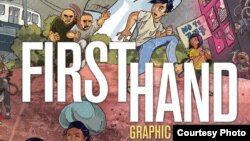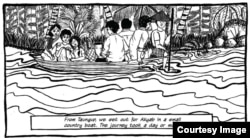The team behind an anthology of 22 illustrated narratives of common, but untold, stories in India is selling out of copies faster than they can produce them.
Thirty-two writers and illustrators collaborated to compile "First Hand," using the graphic novel format to tell stories of female construction workers, the dangerous mountainous trek from Myanmar to India, religious riots in Gujarat, and more.
"First Hand," which sold out all of its first batch of printed copies at its launch party last week, boasts being India’s first anthology of non-fiction comics and illustrated texts, and its team believes in the power of the format to convey a story in a way unattainable by a book or a movie.
“A visual story allows the reader to be transported to where the story happened and when it happened. This can make it feel very immediate,” the anthology’s editor Vidyun Sabhaney said.
The anthology is published by Yoda Press.
Enticing discussion of issues
A key motivation behind the project is telling real stories and addressing real and current issues in this type of visual format. Collaborators tackle many social issues that have been written about, but have not sparked the discussion they think is necessary.
“The experience of living in this country [for many, against great odds], individual and collective struggle, or even social and political injustice... what are the forces that are shaping these? Which events?” asked Sabhaney.
“This understanding most often comes to us as reports, or in the form of books, but rarely as a visual story that can bring them alive with details, characters, location et cetera.”
All stories that have been experienced by hundreds, if not thousands of people, and are stories that many around the country may be familiar with. But many of these people, new residents in a city overwhelmed by transport or a girl struggling to be taken seriously at the police station, may not realize just how common their experiences are.
Recording history
“Since portions of the piece have come into circulation, a few people have come forward to discuss similar survival stories that they have heard from family or friends,” said A.P. Payal, author of the story “Rangoon to Vadakara: A Survivor’s Tale.”
“I wanted for the story to trigger such conversations. I hope that the piece can in some way help bring this aspect of history into public discussion and memory,” he added.
Payal’s contribution tells the story of his aunt whose family crossed the Arakan Mountains to reach India after the Japanese incursion of Myanmar in 1942, an arduous journey made by many in the early days of World War II. Cholera, small pox, wild animals, and treacherous terrain plagued this journey which claimed multiple lives, and yet, “It remains a largely forgotten part of history.”
Pia Alize Hazarika also tells a story forgotten by history, about the survivors of the 2002 riots in Gujarat, which infamously left hundreds of Muslims dead, but the many others injured and displaced have been forgotten.
“These riots themselves might not be 'underrepresented' per se, but what the victims of 2002 were/are going through has conveniently faded into the background,” she said. “No one followed up with them, no one kept any of the promises made and no one is paying attention to what they needed.”
Like Payal, Hazarika is pleased with the reaction she has received so far, hopeful that the visual medium will draw more attention to this issue from a wider audience.
Diverse content
But some stories, such as “Transistor can be Bomb,” aim to relate to readers on less serious matters and make them laugh.
“There have been other illustrated takes on the Delhi Metro, but in my opinion this is a very subtly told story of what could perhaps be any first timer’s experience in a big city,” said illustrator Megha Vishwanath.
“At a minimum, we hope readers will relate to the story. There’s also the understated humor which should leave them amused.”
The diversity of the anthology is a strong selling point, one that editor Sabhaney argues is made possible by the nature of the graphic novel.
“It is very subversive, and allows for many different kinds of storytellers to emerge, unfettered by the demands of a traditional writing or artistic practice.”







